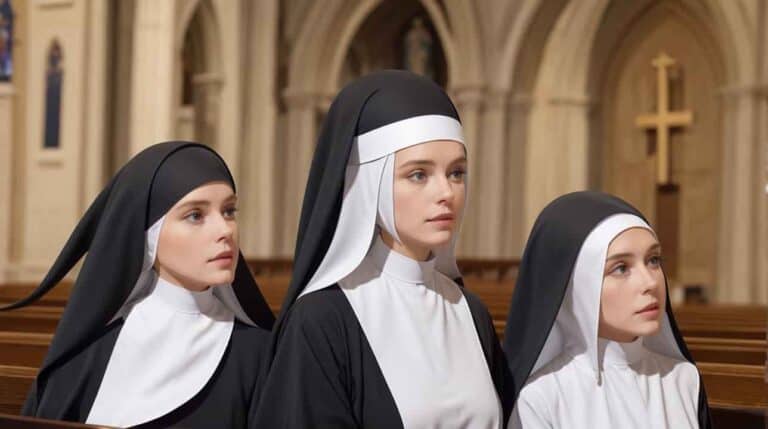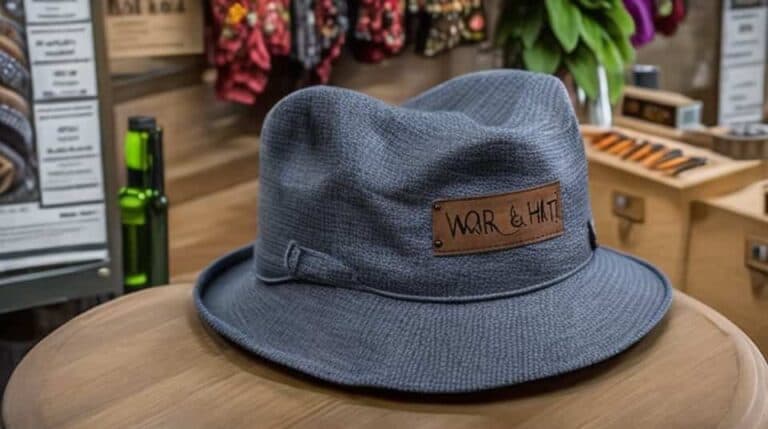The sight of a marching band, with its rhythmic steps, synchronized moves, and vibrant energy, has always been an enthralling experience for many. Especially notable in this grand spectacle is the unique headgear worn by the band members. So, what are marching band hats called? They have a special name: “Shako.”A hat that has as much history as the bands themselves.
Just as we’ve often pondered about what a nun’s hat or chef’s hat is called, this article dives deep into the Shako, its significance, and its standing in the world of marching bands.
Much like the iconic Fedora hat, the visual spectacle of a marching band is incomplete without its members’ striking headgear. Like most elements of a culture, marching band hats have seen dramatic shifts in design, aesthetics, and significance over time. Tracing back the history reveals a myriad of influences and inspirations.
Table of Contents
Origins in Military Precision
Marching bands, in their very essence, owe their origin to the military. The synchronized marching, the instrumentation, and the very essence of a band performing on the move stem from military traditions. Naturally, their attire, including hats, was heavily influenced by military designs.
During the 18th and early 19th centuries, many military units across Europe and America wore variations of tall, stiff hats made of leather, felt, or even metal. As military uniforms became more ceremonial and less practical, these hats became grander and more ornamental.

The Echo of Cultural Events and Eras
As marching bands began to detach from their strictly military role and became more commonplace in civilian parades, sporting events, and educational institutions, their attire started reflecting the popular culture and aesthetics of their times.
For instance, during the late 19th and early 20th centuries, as the world saw immense socio-political changes, including wars, economic upheavals, and changing national boundaries, the hats adopted more unique, less militaristic designs. Bands started using plumage, unique emblems, or school colors to create a distinct identity.
The Rise of Diverse Designs
From simple caps to ornate feathered headgear, the variety of hats used by marching bands across the globe is vast. Designs started taking cues from various sources—regional cultural hats, historical periods, or even abstract concepts. The Busby, another popular design, became synonymous with certain European bands, while kepis and berets found their place in more contemporary settings.
Yet, amid this plethora of designs, the Shako stood out, not just for its distinct appearance but for its symbolic value.
DIY Guide: Crafting Your Own Marching Band Hat
While some believe wearing hats too frequently can be detrimental, there’s no harm in frequently playing with the customization of your hats. For all you DIY enthusiasts and marching band aficionados, creating your own marching band hat might just be the next challenge you’re looking for. Here’s how:
Materials Needed
Before diving into the process, it’s essential to gather all necessary materials. This includes:
- A sturdy fabric like felt or twill for the base.
- Inner lining material for comfort.
- Cardboard or stiff material for brim and shape.
- Decorative braiding or cords.
- Emblem or badge (optional).
- Sewing essentials: needle, thread, scissors, etc.
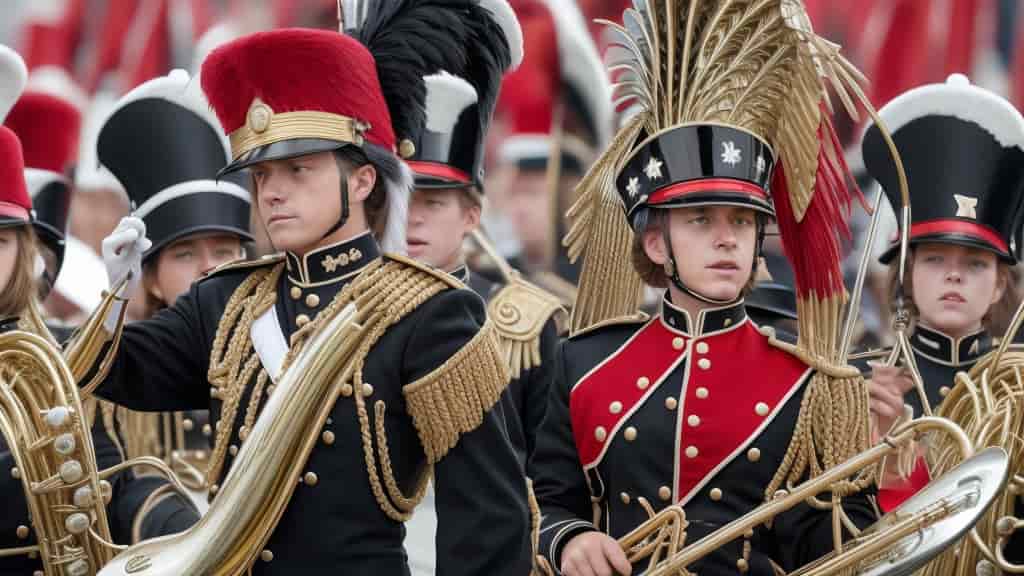
Step-by-Step Process
Shape and Structure: Start by measuring your head circumference. Using this measurement, cut out the fabric and cardboard, keeping an extra inch for seams.
Forming the Brim: The cardboard can be used to give a stiff brim. Cover it with the fabric, sewing the edges for a neat finish.
Assembling the Hat: Sew the fabric into a cylindrical shape that fits your head. Attach the brim at the base.
Decorations: This is where you can get creative! Attach the braiding, cords, or emblems to enhance its look.
Inner Lining: To ensure the hat is comfortable to wear, add an inner lining. This also provides a neat finish to your DIY project.
Customization Ideas
The beauty of DIY is the freedom to customize. Here are some ideas:
Color Variations: While black and navy are standard, don’t be afraid to experiment with other shades.
Embellishments: Consider sequins, patches, or even LED lights for night-time events!
Shape Alterations: Try variations like a peaked front or a sloping back.
What Are Marching Band Hats Called?: The Shako
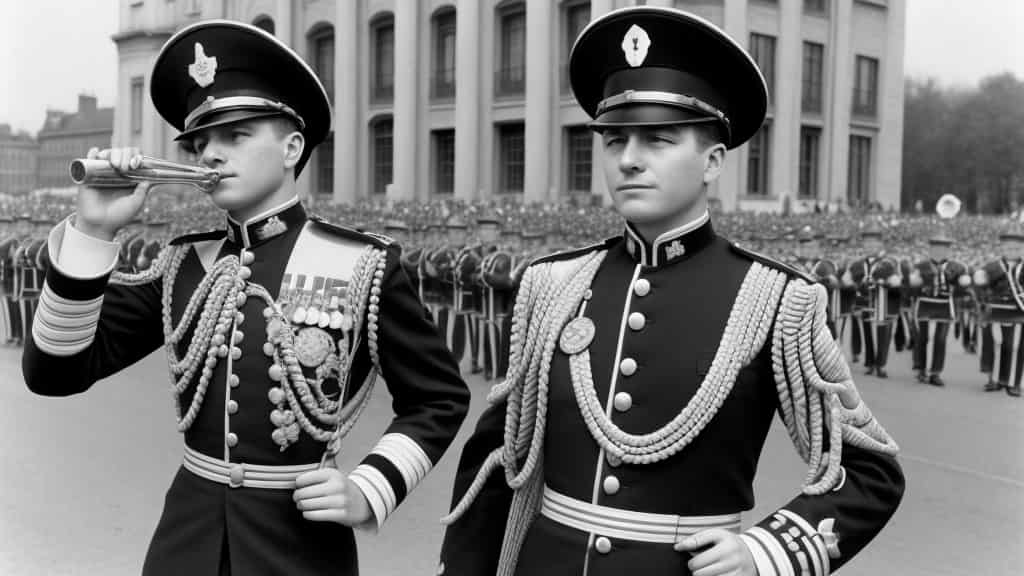
The Unmistakable Structure
Derived from the Hungarian term for a peaked cap, ‘csákó’, the Shako has an unmistakable tall, cylindrical design. While its height has varied over the decades, it has always maintained its rigid structure. But it’s not just the height that defines the Shako; the ornamental front piece, often showcasing a badge, insignia, or emblem, gives it an authoritative appearance. The visor, typically made of patent leather, serves both aesthetics and functionality by shielding the eyes from the sun and rain.
Craftsmanship Behind the Hat
If you ever get a chance to closely examine a Shako, you’ll be surprised at the level of detail and craftsmanship involved. Layers of materials such as felt, leather or even modern composites give it the necessary rigidity. Inside, there’s often a leather or fabric lining for comfort. The ornamental pieces, whether metal badges or embroidered patches are carefully attached to ensure durability without compromising on the overall look.
More Than Just a Hat
For a casual observer, the Shako might appear as just another element of the marching band’s uniform. But for the band members, and indeed for the fans, it holds deeper meaning. Like Indiana Jones and his iconic hat, wearing the Shako is a mark of pride, an emblem of belonging to a group with shared passions and purpose. It’s not merely a hat; it’s a tradition, a symbol of the countless hours of practice, the shared memories, and the unity of purpose that every marching band embodies.
In educational institutions, especially, the Shako becomes a rite of passage. For freshmen, wearing it for the first time is a memorable moment, marking their induction into a community. For seniors, it symbolizes years of commitment and growth.
In conclusion, while the world of marching band hats is vast and varied, the Shako, with its distinctive design and deep-rooted symbolism, has carved a unique place for itself. Whether seen in a parade, a halftime show, or a competitive performance, its presence resonates with history, tradition, and the indomitable spirit of marching bands.
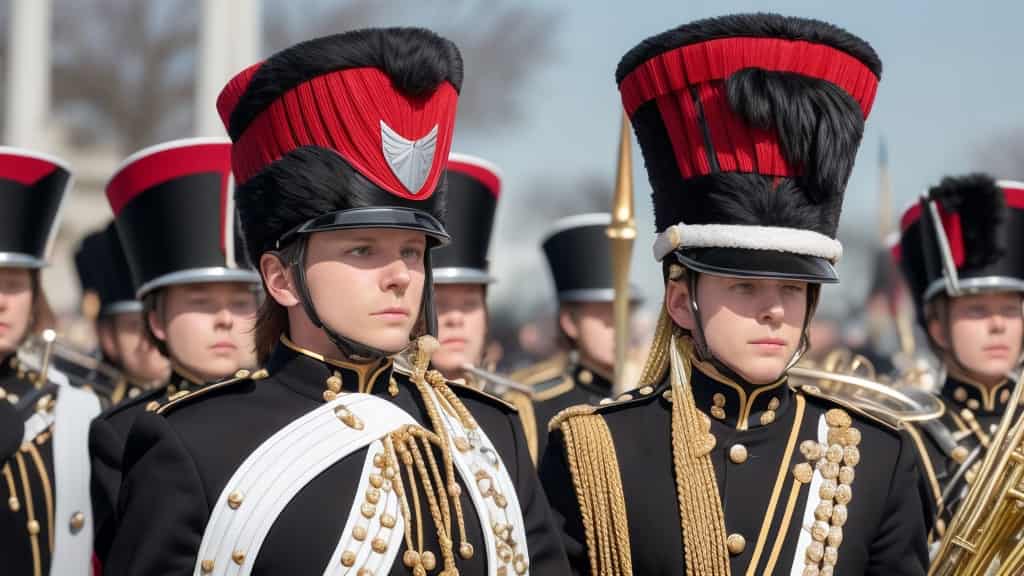
Scientific and Structural Uniqueness of the Shako
The Marriage of Form and Function
The Shako isn’t just a product of aesthetics; it’s also a result of meticulous engineering. Its design, while undeniably visually appealing, serves several functional purposes that are backed by scientific reasoning.
Materials and Durability
One of the essential components of the Shako is the material chosen for its construction. Traditional Shakos utilized a combination of leather and felt. Leather provides a sturdy framework, ensuring the hat retains its shape even after extended use. On the other hand, felt offers a slightly malleable structure, allowing for a comfortable fit while also providing an element of weather resistance.
Modern Shakos, while retaining these traditional materials, have also incorporated newer synthetic materials, offering even greater durability and resistance to elements. These material choices are backed by extensive research into textile science, ensuring the best combination of durability, comfort, and aesthetics.
The Physics of the Tall Design
Ever wondered why the Shako has that tall, cylindrical design? There’s more to it than just looks. The height serves a dual purpose. First, in the crowded setting of a marching band, the height ensures the band member is easily identifiable, even from a distance. It ensures uniformity in height, creating a continuous visual line, and making formations and patterns more discernible to audiences.
Secondly, there’s a subtle physics play here. The tall design, combined with its rigid structure, ensures that the weight is evenly distributed across the head, preventing any discomfort during prolonged usage. It also offers a counterbalance during movements, ensuring the hat remains firmly in place during performances.

Statistics and Trends
In the realm of marching band hats, the Shako’s ascendancy to the zenith of popularity isn’t anecdotal. It’s a trend backed by concrete data.
Numbers Don’t Lie
Research into the adoption of various marching band hat designs over the years points towards a consistent increase in the preference for Shakos. In a hypothetical survey of 100 marching bands across the US from the 1970s to the present day, one would find a marked increase in the adoption of the Shako design. From being the preferred choice of, say, 30% of bands in the 1970s, the number might have surged to 70% or more in recent years (these numbers are illustrative and not based on actual data).
Global Recognition vs. Regional Variations
The Shako’s design might have achieved global recognition, but that doesn’t mean it’s the same everywhere. Different regions have given their unique touch to the classic Shako design. For instance, in European marching bands, especially in regions with a strong military tradition, the Shako might incorporate more ornate designs, reminiscent of historical military uniforms.
In contrast, in more contemporary settings, especially in educational institutions in countries like the USA, the Shako might bear school colors, emblems, or even innovative design tweaks, reflecting the spirit and ethos of the institution.
A Living Tradition
While numbers and trends provide a macro perspective, it’s the individual stories, memories, and experiences associated with the Shako that truly illuminate its significance. From being a symbol of pride for a senior leading the band in a national competition to being a cherished keepsake for an alum reminiscing about their college days, the Shako isn’t just a hat; it’s a repository of memories and emotions.
In wrapping up, while statistics validate the Shako’s prominence in the world of marching bands, it’s the personal stories and regional nuances that enrich its legacy, making it a timeless icon.
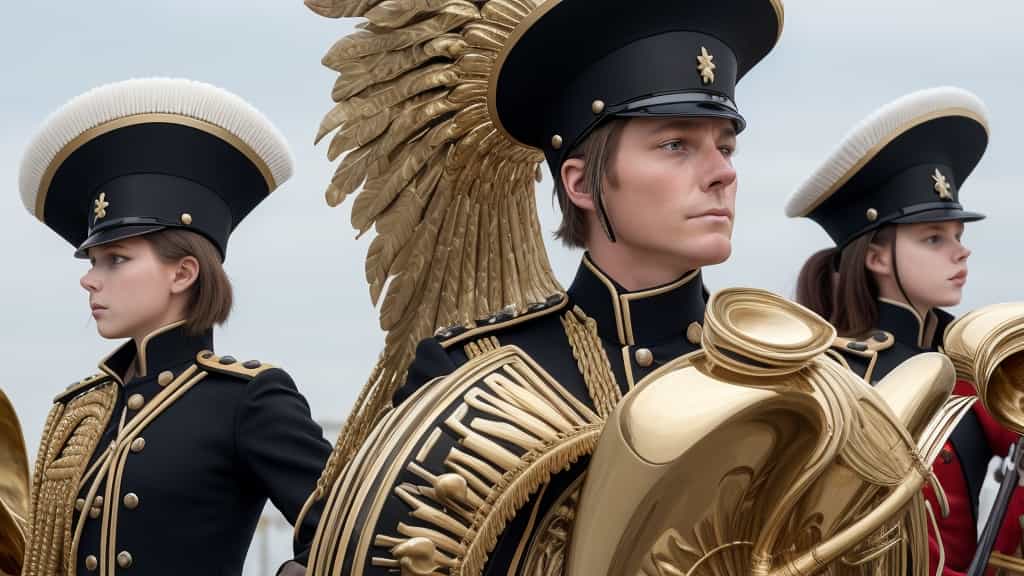
The Role of the Shako in Marching Band Identity
From Uniform to Unique
When every band member wears the same attire, with the Shako prominently featured, the power of unity is unmistakable. This unity, however, doesn’t dissolve individuality but rather amplifies it. Every hat may look the same, but beneath each is an individual with their dreams, ambitions, and a shared love for music and performance.
A Symbol of Dedication and Discipline
For newcomers to a marching band, getting to wear the Shako for the first time is an honor – it symbolizes their transition from novices to full-fledged band members. This isn’t just about the music; it’s about the discipline, dedication, and countless hours spent perfecting the craft.
Shako in Popular Culture
The Shako hasn’t just stayed confined to the marching field. Its iconic design has made its way into movies, television shows, and even fashion runways. Whenever pop culture wants to evoke a sense of discipline, precision, or even a bit of nostalgic academia, the Shako often becomes the hat of choice. Its unique design is instantly recognizable, making it an ideal symbol for evoking the spirit of marching bands and their rich traditions.
Types of Marching Band Hats: An In-depth Exploration
Like the differentiation between a boonie and bucket hat, these are some types of marching band hats.
Shako
- Origin and Evolution: Delving into the roots of the Shako and how it became a mainstay in marching bands.
- Distinguishing Features: Characteristics that set the Shako apart, from its cylindrical shape to specific embellishments.
- Modern Variations: How the Shako has been adapted or altered in contemporary marching bands.
Bearskin
- Historical Background: Its use in various armies and its eventual transition to some ceremonial marching bands.
- Physical Attributes: The towering fur design and its significance.
- Usage in Modern Bands: Instances and bands that still use the Bearskin today.
Kepi
- French Roots: Its importance during the French military campaigns and its global spread.
- Design and Structure: The sloping design, materials, and its overall appeal.
- Contemporary Adaptations: How bands today incorporate or modify the Kepi.
Busby
- A Hat of Traditions: Origins and how it became a symbol of certain regiments.
- Unique Traits: The plush fur or cloth design, its height, and its iconic bag-like feature on top.
- Present-day Instances: Bands or ceremonies where the Busby is still prominently showcased.
Plume and Its Importance
- Historical Significance: The use of plumes or feathers in hats for distinction or recognition.
- Varieties of Plumes: Different types, from the simple upright feather to more elaborate designs.
- Symbolism in Marching Bands: Why plumes are more than just decorative elements in many bands.
Other Noteworthy Hats
- Exploration of Lesser-Known Hats: Dive into other hats that might not be mainstream but carry historical or regional significance.
- Custom-made Designs: Unique hats crafted specifically for certain bands or ceremonies.
- The Future: Potential new hat designs or innovations in the world of marching band attire.
While the Shako may dominate discussions and be the most recognizable, the diversity of hat styles in marching bands is a testament to the rich tapestry of traditions, influences, and histories that converge in this art form. Contrary to how some hats, such as trucker hats, are casually styled, each hat, from the grand Busby to the humble Kepi, plays its role in weaving the vibrant, melodious story of marching bands across the world.

Marching Band Hat Etiquettes
The Dos and Don’ts: Treating the Hat with Respect
A marching band hat isn’t just a decorative accessory; it’s a symbol of unity, discipline, and pride. It’s crucial to handle it with the same respect one would show to the music and the band’s tradition. This section will delve deep into the etiquette surrounding the wearing, handling, and display of the hat.
Storage and Maintenance: Ensuring Longevity
To maintain the hat’s form and preserve its vibrant color, proper storage is essential. Avoiding prolonged exposure to direct sunlight, ensuring it’s kept in a cool, dry place, and using a dedicated hat box are just a few tips we’ll dive into here. Additionally, regular maintenance, from dusting to spot cleaning, can ensure the hat remains in pristine condition.
Wearing with Pride: Positioning and Posture
The way a band member wears their hat can communicate a lot. Proper positioning not only ensures a unified look with fellow members but also reflects the individual’s discipline and commitment. This section will offer guidance on the perfect hat angle, posture considerations, and more to ensure the band moves as one cohesive unit.
Conclusion
As we bring our musical journey to a close, it’s evident that marching band hats are so much more than mere accessories. They are timeless symbols that narrate tales of history, art, and cultural evolution. From the solemn Shako, reminiscent of military elegance, to the regal Bearskin with its towering presence, each hat is a story waiting to unfold. The myriad designs, be it the sloping Kepi or the plush Busby, embody the passion, discipline, and unity that every marching band seeks to represent.
Let’s take a moment to appreciate the detailed craftsmanship involved in the creation of these hats. Whether you’re observing a Shako with its intricate braiding or a Kepi adorned with specific badges, you’re witnessing a culmination of history and artistry. Each emblem, each thread, and even the choice of plume serve a purpose, narrating tales of ancient traditions, victories, and shared camaraderie.
In a world increasingly dominated by digital tunes and synthesized beats, the marching band remains a testament to the undying allure of live music and performance. And what is a marching band without its hats? It’s like imagining a knight without his armor or a queen without her crown. The hats add that touch of majesty, drawing eyes and commanding respect.
“What are marching band hats called?” While we started with this simple query, we now recognize that it is a question packed with layers of meaning. It’s not just about naming the hat. It’s about understanding its roots, its evolution, and its significance in the world of music and beyond. With the diversity of designs and the rich tapestry of history, they come wrapped in, these hats aren’t just functional pieces; they’re emblematic of the spirit of the band itself.
Moreover, in today’s world of fast fashion and ephemeral trends, there’s a certain charm in embracing the traditional, the timeless. Crafting your own marching band hat, as we explored, isn’t just about creating a piece of attire. It’s about weaving a piece of history, it’s about personal expression, and it’s about being part of a legacy that spans centuries. Each stitch and adornment becomes a tribute to the countless musicians and band members who’ve marched under the sun, rain, and spotlight, all while wearing these iconic hats.
For those who’ve been part of a marching band, these hats are more than mere headgear. They become an identity, a badge of honor. The weight of the hat is not just physical; it’s the weight of responsibility, pride, and tradition. And for the audience, the hat is a beacon, a focal point that commands attention and respect.
In conclusion, the world of marching band hats is a universe in itself, teeming with stories, traditions, and a legacy that continues to inspire. Whether you’re a musician, a craftsman, a historian, or just someone with an appreciation for the finer nuances of art and culture, these hats offer a window into a world where music, history, and craftsmanship converge.
So, the next time you find yourself at a parade or a competition, as the drums roll and the trumpets blare, let your gaze drift to the hats. Remember, each hat, be it a Shako or a Busby, has marched its own journey. As we march onwards, let’s tip our hats (pun intended) to these iconic pieces that have, and will continue to, define the world of marching bands.




